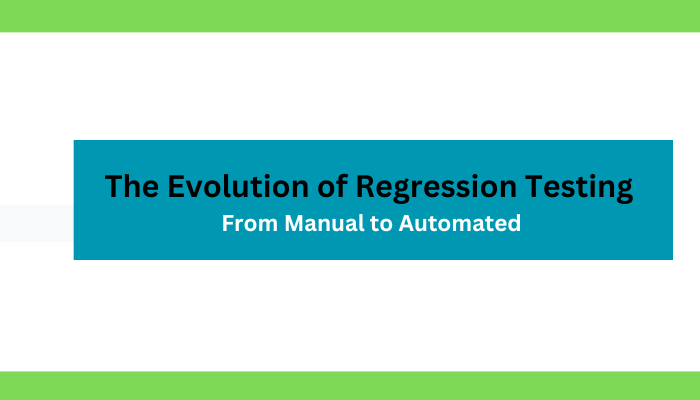The Evolution of Regression Testing: From Manual to Automated
 Leeanna Marshall
Leeanna Marshall
In the ever-evolving landscape of software development, the process of regression testing has undergone a remarkable transformation, transitioning from manual to automated methodologies. This journey is marked by challenges, breakthroughs, and the emergence of innovative testing approaches, including the revolutionary concept of visual regression testing.
1. Introduction
A. Definition and Importance of Regression Testing
Regression testing is a cornerstone in the software development life cycle, ensuring that code changes do not adversely affect the existing functionality of an application. Its primary goal is to catch unintended side effects that may occur when new features are added or existing features are modified. This iterative testing process plays a crucial role in maintaining the overall integrity and reliability of software.
B. The Challenges of Manual Regression Testing
Traditionally, regression testing was a manual affair, demanding meticulous, hands-on verification of every code change. While manual testing provided a thorough examination, it was time-consuming, resource-intensive, and prone to human error. The challenges of keeping pace with rapid development cycles became increasingly apparent, necessitating a more efficient approach.
2. Manual Regression Testing
A. Explanation of Manual Regression Testing Process
Manual regression testing involves the meticulous execution of test cases by human testers. This process demands a comprehensive understanding of the application's functionality, requiring testers to meticulously navigate through the software, identifying and documenting any deviations from the expected behaviour.
B. The Limitations of Manual Regression Testing
While manual regression testing offers a detailed examination of software changes, it has inherent limitations. The risk of human error is ever-present, and the time required for repetitive testing tasks is a significant drawback in the context of today's fast-paced development cycles.
C. Time and Resource Constraints
The constraints of time and resources often hinder the effectiveness of manual regression testing. As development teams strive for quicker releases and continuous integration, the demands on manual testers become increasingly challenging to meet.
3. Introduction to Automated Regression Testing
A. Definition and Benefits of Automated Regression Testing
The evolution of regression testing saw a paradigm shift with the introduction of automated testing. Automated regression testing involves the use of specialised tools to execute test cases and verify that new code changes do not introduce defects. This approach offers a myriad of benefits, including increased efficiency, repeatability, and reduced manual effort.
B. How Automation Improves Efficiency and Accuracy
Automation enhances efficiency by rapidly executing test cases, allowing for quicker feedback on code changes. The precision and accuracy of automated testing reduce the likelihood of human errors, contributing to the overall reliability of the testing process.
C. Cost-Effectiveness of Automation
While the initial setup of automated testing may require an investment, the long-term benefits in terms of reduced manual effort and faster release cycles make it a cost-effective solution. Automated regression testing proves instrumental in achieving a higher return on investment over time.
4. Visual Regression Testing
A. What is Visual Regression Testing?
Visual regression testing represents a quantum leap in the evolution of testing methodologies. Unlike traditional regression testing that focuses solely on functional aspects, visual regression testing places a premium on the visual elements of an application. It ensures that code changes do not introduce unintended alterations to the user interface.
B. Advantages of Visual Regression Testing over Traditional Methods
The advantages of visual regression testing are significant. It goes beyond detecting functional issues to identify subtle visual anomalies that might be overlooked in traditional testing methods. This approach is especially crucial in industries where the user interface plays a vital role in the user experience.
C. Real-Life Examples of Successful Visual Regression Testing
Real-world success stories attest to the effectiveness of visual regression testing. Companies across various industries have embraced this innovative testing approach, preventing visual defects from reaching end-users and maintaining a polished, professional appearance.
5. Key Considerations for Visual Regression Testing Implementation
A. Tools and Software Available for Visual Regression Testing
Implementing visual regression testing requires the right tools. Numerous software solutions, such as Percy, Applitools, and BackstopJS, are available, each offering unique features to cater to different testing needs.
B. Training and Skill Required to Implement Visual Regression Testing
Successfully implementing visual regression testing necessitates training and skill development. Testers need to understand the intricacies of visual testing and how to interpret results accurately.
C. Integration with Existing Testing Processes
Integrating visual regression testing into existing testing processes is essential for its seamless adoption. It should complement other testing methodologies, providing a comprehensive quality assurance strategy.
6. Best Practices for Visual Regression Testing
A. Defining a Regression Testing Strategy
Developing a comprehensive regression testing strategy is fundamental to successful visual regression testing. Clearly defined objectives and a systematic approach ensure that all aspects of the application are adequately covered.
B. Identifying Critical Visual Elements for Testing
Identifying critical visual elements for testing is crucial. Testers must prioritise elements that significantly contribute to the user experience, ensuring that any changes do not compromise the application's visual integrity.
C. Setting Up an Effective Test Environment
Creating an effective test environment involves meticulous planning. Version control, baseline image management, and a controlled testing environment contribute to the success of visual regression testing.
7. Challenges and Limitations of Visual Regression Testing
A. False Positives and False Negatives
One of the challenges in visual regression testing is the occurrence of false positives and false negatives. Testers must navigate these challenges to ensure accurate results and minimise the risk of overlooking potential issues.
B. Handling Dynamic and Responsive Interfaces
Dynamic and responsive interfaces present unique challenges in visual regression testing. Variations introduced by different screen sizes and resolutions require testers to adapt their testing strategies for accurate results.
C. Maintaining Test Stability and Data Consistency
Maintaining stability in visual regression testing is critical for reliable results. Testers must address challenges related to evolving interfaces and ensure consistency in test data to prevent misleading outcomes.
8. A Hybrid Approach: Combining Manual and Automated Regression Testing
A. When and Why to Use a Hybrid Approach
In certain scenarios, a hybrid approach that combines the strengths of both manual and automated testing is optimal. This approach is particularly effective when dealing with complex test scenarios that demand a nuanced, human touch.
B. Integrating Manual and Visual Regression Testing
Integrating manual and visual regression testing into a cohesive strategy requires thoughtful planning. By leveraging the strengths of both approaches, development teams can achieve comprehensive test coverage and robust application quality.
9. The Future of Regression Testing
A. The Role of AI and Machine Learning in Regression Testing
The future of regression testing is intertwined with advancements in artificial intelligence (AI) and machine learning (ML). These technologies are poised to revolutionise testing by automating complex tasks, predicting potential issues, and providing intelligent insights.
B. Predictions and Trends in the Field
Predicting future trends in regression testing involves anticipating the continuous evolution of testing methodologies. Innovations such as increased automation, improved tooling, and enhanced predictive analysis are expected to shape the landscape.
C. Continuous Integration and Regression Testing
The synergy between continuous integration and regression testing is expected to deepen. Automation in the continuous integration pipeline will become even more integral to maintaining the balance between speed and quality in agile development environments.
10. Conclusion
A. Recap of the Evolution of Regression Testing
In conclusion, the evolution of regression testing showcases a remarkable journey from manual processes to sophisticated automated and visual methodologies. Manual regression testing, although foundational, grappled with time constraints, resource limitations, and the inherent risk of human error. However, the advent of automated regression testing revolutionised the landscape, offering unparalleled efficiency, accuracy, and cost-effectiveness.
Visual regression testing further elevated the testing paradigm by focusing not only on functionality but also on the visual aspects of applications. Its ability to detect subtle visual anomalies and prevent regression issues that might be overlooked in traditional methods has become invaluable in industries where user interface excellence is paramount.
B. Importance of Adapting to Automated and Visual Regression Testing
Emphasising the critical importance of adapting to automated and visual regression testing is crucial for development teams seeking to thrive in the modern software development ecosystem. The benefits of increased efficiency, accuracy, and the ability to catch visual defects early are imperative in meeting the demands of agile development cycles.
C. Final Thoughts on the Future of Regression Testing
As we reflect on the ongoing evolution of regression testing, it's clear that the future holds exciting prospects. The integration of AI and machine learning, emerging trends, and the deepening synergy with continuous integration all point to a dynamic and innovative future for regression testing. Staying abreast of these developments and embracing a forward-looking mindset will be key for development teams aiming to deliver high-quality software in a rapidly changing landscape.
Reference - Everything you need to know about Regression Testing
Subscribe to my newsletter
Read articles from Leeanna Marshall directly inside your inbox. Subscribe to the newsletter, and don't miss out.
Written by

Leeanna Marshall
Leeanna Marshall
Hello, I'm Leeanna Marshall, an ardent enthusiast of all things automation and a passionate blogger. My journey in the world of automation has led me to explore the fascinating intersection of technology and efficiency. Through my blog, I delve into the intricate realms of automation, sharing insights, tips, and trends that empower individuals and businesses to embrace the future of streamlined processes.